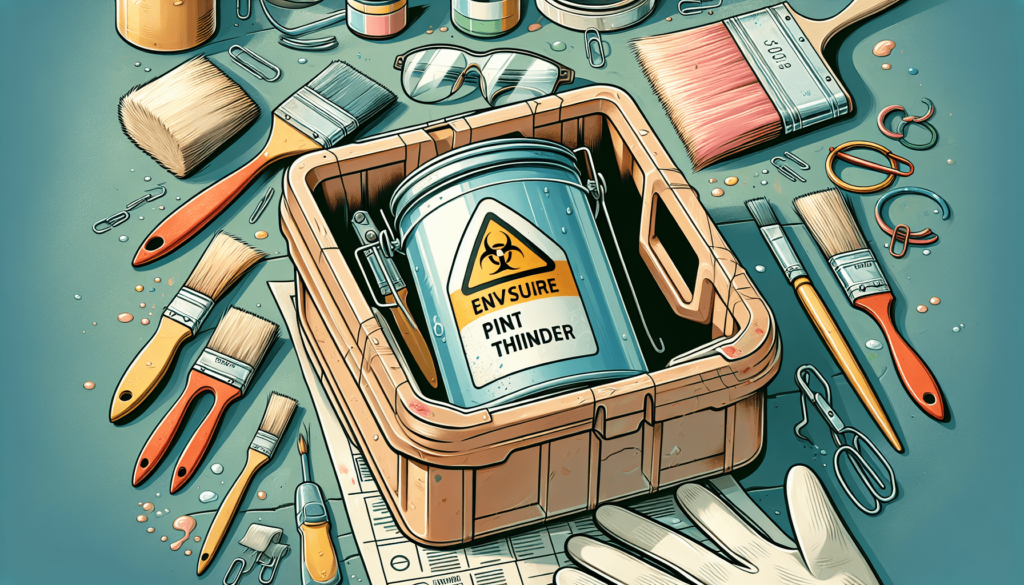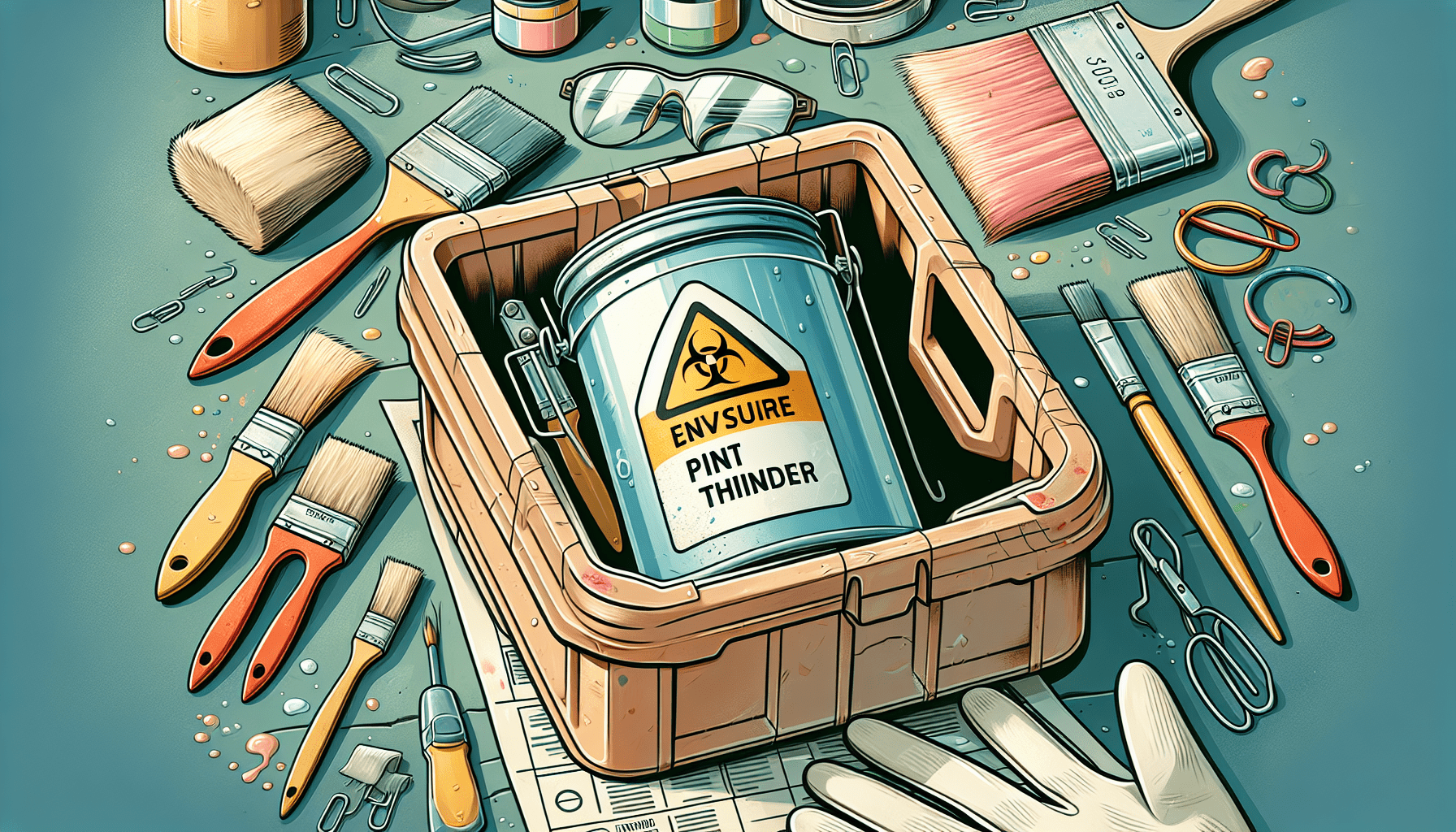Navigating the complexities of managing hazardous waste like paint thinner can be a challenging task. In this guide titled “How To Dispose Of Paint Thinner After Cleaning Brushes,” you will learn about the essential steps necessary to properly manage the disposal of paint thinner used for cleaning brushes. The article aims to make it easier for you to follow the eco-friendly and legal guidelines, reduce risk to your health and environment, and extend the shelf-life of your tools. With this, you can contribute to the earth’s protection and continue your creative journey without worrying about the impact of paint thinner waste.

Check Local Regulations
Before you proceed with the disposal of paint thinner, make sure to verify the local rules and regulations surrounding paint thinner disposal. This is critical as these rules vary significantly across different regions and can greatly impact how you go about the disposal process.
Research Local Disposal Laws
Spend some time researching the local regulations regarding the disposal of hazardous substances like paint thinner. You can usually find this information on your state or city’s website, or by contacting the proper local authorities. Understanding the laws will help ensure that you are compliant and will prevent potential legal issues.
Contact Local Waste Management Authority
To get precise information about how to dispose of paint thinner properly, it can be helpful to contact your local waste management authority directly. This can be done either by phone or by email. They can provide specific instructions for your locality and answer any questions you may have about the process.
Reuse or Recycle
If you cannot dispose of the paint thinner directly, consider its possible reuse or recycling. This approach can benefit both the environment and your wallet.
Consider Reusing Paint Thinner
People often underestimate how long paint thinner can be useful for. If stored properly, paint thinner can last for several years. So, consider reusing your paint thinner for future painting jobs. You can strain it through a coffee filter to remove any leftover paint and store it in a clean, airtight container.
Find a Paint Thinner Recycling Facility
Before disposing of your paint thinner, check if a recycling facility in your area accepts it. Many areas have specific facilities equipped to handle hazardous waste like this. The recycled paint thinner can often be used for various industrial processes, making this a more eco-friendly disposal option.
Contact Paint Suppliers
Some paint shops offer recycling programs for their customers. Check with your local paint suppliers to see if they have such a program. If they do, they can guide you through their specific process for recycling paint thinner.
Evaporation Method
If your local regulations allow, an alternative method for disposing of paint thinner is through evaporation.
Pour Used Paint Thinner into a Wide Container
Decant the used paint thinner into a wide, shallow container. The resultant increased surface area expedites the evaporation process.
Leave the Container Open in a Well-Ventilated Area
Place the container in a well-ventilated area — preferably outdoors and out of the reach of children and pets. This will minimize the risk of inhaling harmful fumes.
Allow Thinner to Evaporate Completely
Allow the paint thinner to evaporate entirely. Once the liquid has disappeared, what remains will be a semi-solid residue.
Dispose of the Empty Container
After the thinner has entirely evaporated, the container can be disposed of as regular waste. If there’s any semi-solid residue, follow your local hazardous waste guidelines for proper disposal.
Absorption Method
An alternative disposal method is the absorption technique, which involves absorbing the paint thinner using a material like kitty litter, sawdust, or paper towels.
Mix Paint Thinner with an Absorbent Material
Start by gradually adding an absorbent material into the paint thinner.
Use Kitty Litter, Sawdust, or Paper Towels
Common absorbent materials include kitty litter, sawdust, and paper towels. Each of these has excellent absorption properties that can soak up the paint thinner quickly.
Allow the Material to Soak Up the Thinner
Stir the absorbent material into the paint thinner and let it stand until it’s absorbed all of the liquid.
Place the Absorbed Mixture in a Sealed Bag or Container
Once fully absorbed, place the mixture in a sealed bag or container to avoid any potential spills or leaks.
Dispose of the Sealed Bag or Container
Finally, dispose of the bag or container according to your local regulations for hazardous waste.

Solidification Method
The solidification method is another useful technique for disposing of unwanted paint thinner.
Purchase a Paint Hardener
Start by purchasing a paint hardener from a local home improvement or paint store. These products are specifically designed to solidify paint making it safe for disposal.
Mix the Paint Thinner with the Hardening Agent
Next, mix the paint thinner with the hardening agent following the manufacturer’s instructions.
Stir Until the Mixture Turns Solid
Continue stirring until the mixture solidifies. This process can take a few minutes to several hours depending on the quantity and the specific hardening agent used.
Dispose of the Solid Waste
Once the mixture has hardened, you may throw it away according to the guidelines set by your local waste disposal authority.
Professional Disposal
If you’re unsure about dealing with paint thinner disposal, consider reaching out to professional hazardous waste disposal companies.
Contact Hazardous Waste Disposal Companies
These companies specialize in disposing of dangerous waste and have the necessary expertise to handle substances like paint thinner.
Schedule a Pickup or Drop-off
Most of these companies offer different options for disposal. Some provide a pickup service at your doorstep, while others may require you to deliver the waste to a designated facility.
Ask about Fees and Requirements
Make sure to inquire about any fees associated with the service and any specific requirements for packaging and transporting the paint thinner.

Community Hazardous Waste Collection Events
Many communities organize hazardous waste collection events which can be a good avenue to dispose of paint thinner.
Check for Local Events
Regularly check with your city or local waste management authority for any upcoming hazardous waste collection events.
Collect Paint Thinner in Approved Containers
For these events, you will typically need to collect your paint thinner in approved containers. You can find information about the types of approved containers in your event’s guidelines.
Follow Event Guidelines
Adhering to the event guidelines is critical to ensure the successful and safe disposal of your paint thinner.
Drop off the Thinner at the Designated Location
On the day of the event, deliver your paint thinner to the designated location.
Paint Thinner Disposal Alternatives
There are several alternatives to disposing of paint thinner that can help reduce its environmental impact.
Reducing Paint Thinner Usage
The most direct way to reduce the need for paint thinner disposal is by using less of it. This can be done by optimizing your painting techniques and cleaning brushes immediately after use.
Switching to Low VOC Paints
Another alternative is switching to paints with low volatile organic compounds (VOC). These paints require less thinner, which results in less waste.
Water-Based Paints as an Alternative
Water-based paints are a safer alternative because they are less toxic than oil-based paints and don’t require the usage of paint thinners for cleaning brushes.
Cleaning Brushes with Less Thinner
By using less paint thinner to clean your brushes, you can decrease the amount of waste you generate. This can be achieved by removing as much paint as possible from your brush before cleaning it with thinner.

Labeling and Storage
Proper labeling and storage of paint thinner are crucial for safety and longevity.
Label Containers Clearly
Always label your containers clearly with the contents, date, and any necessary safety warnings.
Store Paint Thinner in a Cool, Dry, and Safe Place
Keep your paint thinner in a cool, dry and safe place away from children, pets, and ignition sources.
Keep Away from Heat and Flames
Due to its highly flammable nature, make sure to store paint thinner away from heat sources and open flames.
Safe Storage Practices
Choose high-quality containers with a good lid seal to prevent leaks and spills. Also, it’s highly recommended to store paint thinner containers upright to lower the risk of leaks.
Environmental Impact
Disposal of paint thinner should be done responsibly to minimize the environmental impact.
Understanding the Environmental Risks
Paint thinner is hazardous to both human health and the environment. Proper disposal is necessary to prevent harm to the ecosystem and our health.
Avoiding Pouring Thinner Down the Drain
Never pour paint thinner down the drain. This is not only illegal in most places, but it can also cause serious damage to your plumbing and contaminate local water sources.
Preventing Soil and Water Contamination
Avoid disposing of paint thinner in the trash or onto the ground to prevent soil and water contamination. Always dispose of paint thinner according to local regulations and guidelines, using any of the methods mentioned in this guide.




